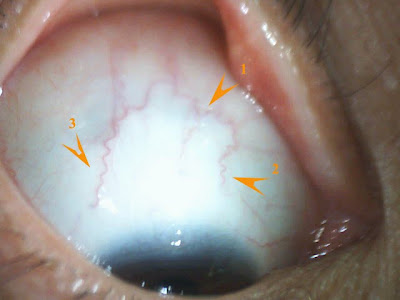Rx - Sclera :
Female, Age: 45
1) Stress line emanate from the vital force or hypothalamus reflex zone extending to the edge of the iris. The concentrated stress with Y-formation at the pineal and pituitary reflex zone.
2) Tracer line from the pineal or pituitary crossing towards to the quadrant of the thyroid zone, indicates glandular fatigue and endocrine gland insufficiency.
3) Congestion line extends to the hypothalamus reflex area, suggest stress in hypothalamus. Emotional stress and imbalance.
1) Tracer line crossing the thyroid zone indicate potential thyroid stress, miscommunication and weaknesses in endocrine gland.
2) Possible stress in larynx and esophagus.
3) Small y-fork stress line situated at the area of esophagus.
4) Yellow tint patches concern with liver involvement.
1) Encapsulation stress at the lung zone.
2) Potential lymphatic stagnation and congestion.
1) Pancreas Y line occur higher and crossing towards to the edge of the iris are expressing insufficiency in digestive system, pancreatic enzyme deficiency.
2) Stress line in colon area, potential gastrointestinal disturbances, this can be confirmed by analyze the inner pupillary zone of the iris collarette.
3) Congestion line crossing adrenal and kidney to the prostate areas, suggest kidney stress, adrenal fatigue and possible disturbances in uterus, will counter-check in iris analysis...
Left Sclera :
1) Stress in vital force or animation of life are relating to the brain fatigue, loss of vitality and life energy - Qi, poor circulation to the brain, emotional imbalance and possible of unresolved emotional trauma.
2) The stress line directly crossing to the lung quadrant.
3) Congestion line in pineal and pituitary zone accompanied and intertwined with the secondary involvement of stress line (4), suggests that two causative factors are involved.
1) Stress line extending from the brain quadrant, the Y line (concentrated force) branching out to the lung and heart areas, potential stress in lung and heart function.
2) Lung stress line connecting with the cardiovascular congestion line (3) heading to heart zone (3a) near the edge of the iris, suggest heart stress and cardiovascular risk.
Thyroid congestion line, tendency to hypo/hyperthyroidism.
1) Suggest adrenal stress.
2) Congestion line crossing the small intestine to the spleen area. Suggest disturbances in small intestine and spleen deficiency.
Multidimensional Iridology Analysis
Rx-Iris
1) Defect marking at 5' on the border of the collarette suggest pituitary stress.
2) Defect markings at 25' on the border of the collarette suggest pineal stress and sinusitis problem.
3) Internal lacuna located inside the collarette - 93' and crypt located nearest to the edge of the IPB- 110' indicates disturbances in small intestine, ileum reflex areas.
4) Crypts formation situating nearest to the edge of the IPB - 131' possible deficiency in pylorus area.
5) Cryptiform at the internal border of the distension of the collarette - 143' indicating deficiency in jejunum area.
6) Crypts at 173' indicates kidney stress.
7) Crypt on the outside of the border collarette suggest adrenal stress at 180'.
8) Multiple brown patches scattered around the ovary reflex zone - 210' indicates ovarian stress and possible liver stress involvement.
9) Crypt at the edge of the border collarette - 240' suggest nasal problem.
10) Crypts at the edge of the border collarette - 285' suggest thyroid problem, tendency to hypo/hyper thyroidism, and also relate to heart problem.
11) Defect marking on the edge of the collarette - 297' indicates pancreas deficiency, potential of blood sugar imbalance or pancreatic enzyme deficiency.
1) Crypts inside the pupillary zone - 23' suggest pituitary stress and possible maxillary sinus problem.
2) Internal lacuna situated in the inner pupillary zone - 53' suggest vitamin and mineral deficiencies condition.
3) Crypts located the local distended collarette - 155' indicates potential stress in bladder and duodenum disturbances.
4) Crypts at 230' indicate pancreas dysfunction.
5) Crypts at 253' possible thymus stress, concern with immunological system.
6) Crypts at 308' & 322' suggest stress in ileum.
7) Internal lacuna at 350' relate to transverse colon.
8) Crypt at 358' suggest pituitary and hypothalamus stress.
a) Local hypertrophy of the IPB.
b) Arheological - N sign.
c) Rectangular Sign - gastrointestinal disturbances
d) Archeological - Climber
e) Pupil flattening - 92' ~ 117'
- Physical spinal stress in thoracic vertebrae.
- Lateral temporal flatness :
1) circulatory problem
2) Tendency to asthmatic problem
3) Emotional heart problem
4) Concerns connection in small intestine problems such as Crohn's disease and duodenitis.
Archeological Sign - Climber
a) Hypertrophy of the frontal IPB structure - Lx, suggest tendency to thyroid dysfunction and blood sugar imbalance.
b) IPB Rectangular Sign.













No comments:
Post a Comment